Glofish fish: glowing fluorescent aquarium dwellers
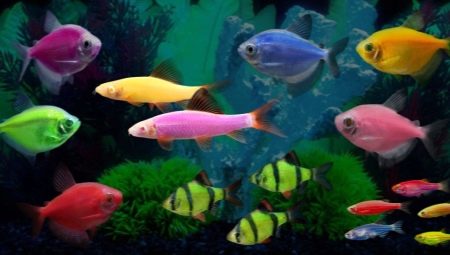
When choosing pets for an aquarium, many stop at glowing fish. Small fluorescent inhabitants are good because they glow beautifully in the dark, and they look no worse during the day. How to properly care for them, what special characteristics they have, we will consider below.
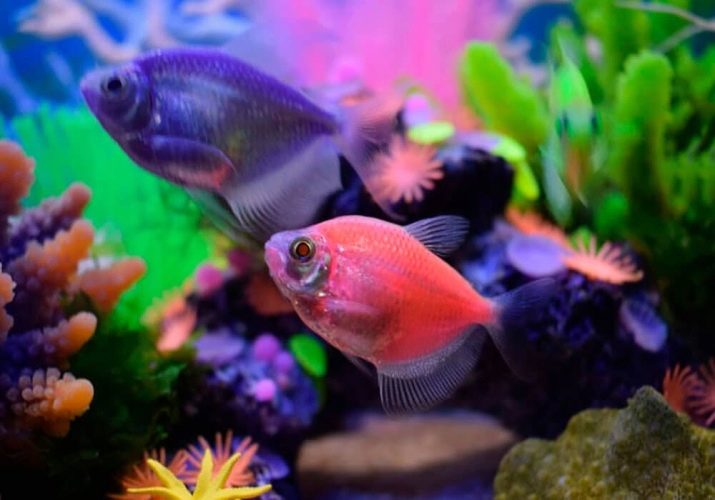
History of appearance
The very first glowing fish is well known to any aquarist, and not only. This is nothing but neon. The story of the discovery of the tiny fish began in America, where Rabo, a French explorer, arrived. Seriously ill, he was picked up by the local Indians, who saved him from certain death. It was in their village that he saw a beautiful firefly fish; he took several individuals of this species to his homeland.
Then science took a step further, and at the end of the 20th century, scientists began to conduct various experiments, studying animal cells. One of the studied individuals was the Pacific jellyfish, which can glow in the dark. The gene for this jellyfish was isolated, and then it was introduced to the first experimental - zebrafish. At first, nothing worked, but a little later the researchers managed to bring out the fish, which, with their glow, signaled changes in water parameters.
The delighted scientists presented the fish at scientific conferences, and then the unexpected happened: individuals, bred exclusively for science, suddenly found success with breeders of interesting fish. A little later, in 2003, scientists signed a deal with breeders and businessmen, and the company for the production of fish began to be called GloFish.The head office of the company is located in Hong Kong, and the pets that the company breeds have long been among the favorites of many aquarists.
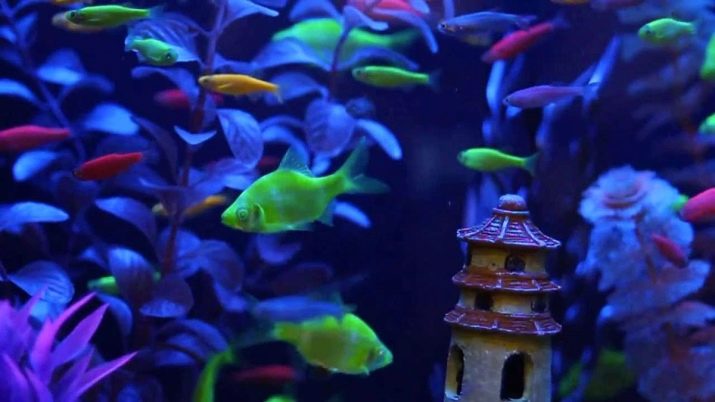
Popular varieties
There are several varieties of glowing fish, obtained both artificially and naturally.
- Neon. As already noted, neon is a fish that can be found in nature. In the middle of the body, neon has a bright glowing strip. Males have a straight stripe, females a rounded one. Common fish are reddish blue, but there are many other artificial colors as well. This means that a special paint is injected into the neon body.
Such a fish looks amazing, but lives very little due to the toxicity of the pigment.
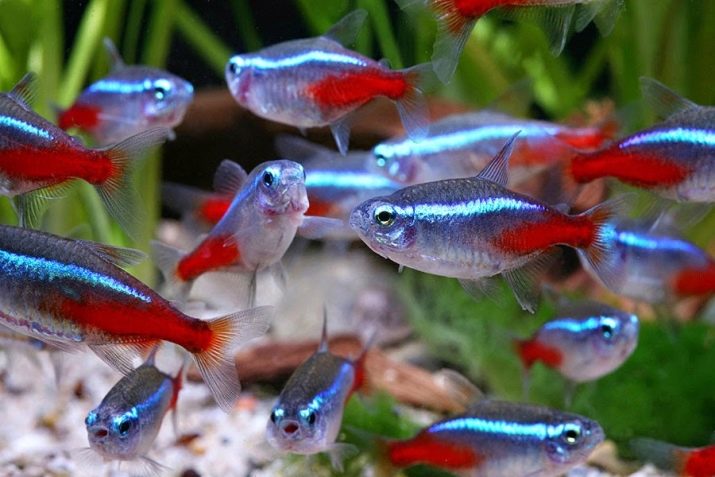
- Erythrozonus. These fish are quite similar to neons, but have a transparent body. There is also a stripe along the body, which usually has a deep red color. Erythrozonus is very easy to breed at home.
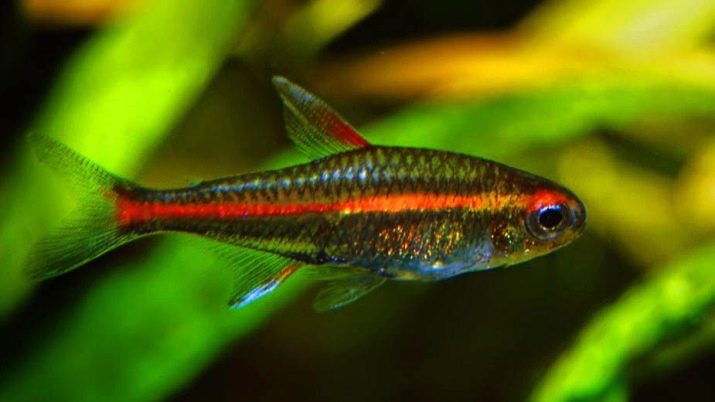
- Danio. Such fish were the first experimental scientists. At first, zebrafish gleamed exclusively green, thanks to the jellyfish gene, today, red, yellow and orange fish obtained through long research are available to aquarists.

- Thornsia. A stunningly beautiful rounded fish, ready to give the aquarium the whole spectrum of the rainbow. Well suited for beginners, as it is not particularly whimsical. Every year, scientists are developing new species with different colors. An interesting fact is that with poor maintenance, fish can change color, it becomes more faded.
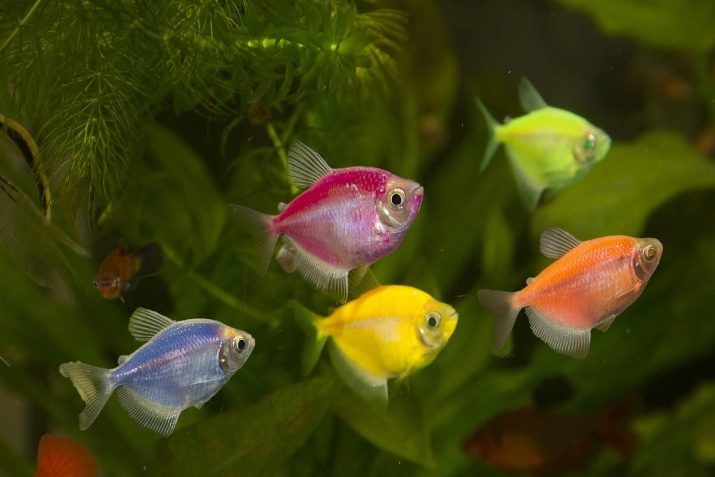
- Barbus. The GloFish company did not pass by its attention and restless barbs. The Sumatran subspecies is especially popular. These are fish of a yellow-green saturated color, and they show their qualities especially brightly, being under ultraviolet rays.
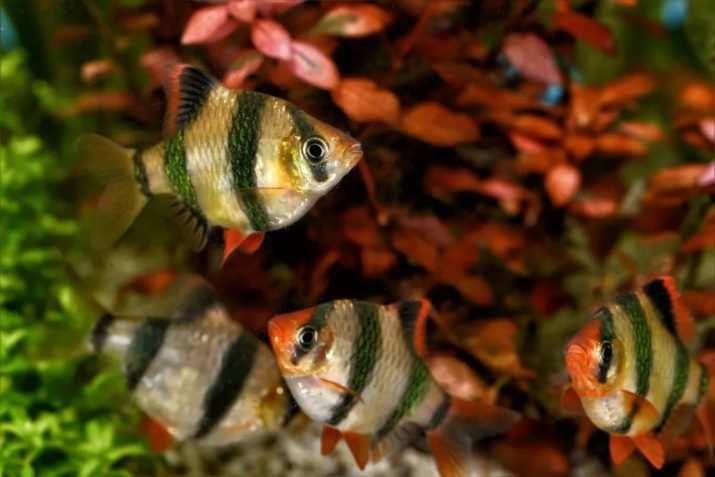
- Scalar. An interesting fish from the genus of cichlids. She became the next person to experiment on. And if everything was quite simple with schooling small fish, here scientists had to try so that such a pet could reproduce successfully.

Maintenance and care
Despite the fact that fluorescent fish look extremely unusual, caring for them will not be too burdensome, since they are the same standard fish, only glowing. Behavior, character, eating habits are the same as those of ordinary pets. Therefore, the content will almost entirely depend on the type you choose. We will give some of the most general recommendations.
Genetically modified fish, as a rule, prefer rather high water temperatures - 28-29 degrees.
This is due to the fact that from birth they contain genes of tropical creatures that need a warm habitat. Stiffness and acidity are selected depending on the type of fish. The water is changed every 14 days, but no more than a third of the total volume is changed. They are fed standard food, both dry and frozen. Live protein supplements, such as bloodworms or daphnia, will be mandatory. Like ordinary fish, fluorescent fish should not be overfed, this is fraught with multiple diseases, the most harmless of which is obesity.

Every year the GloFish company receives more and more orders, so the companies that produce decorations for aquariums do not hesitate either. Special glowing decorations designed to highlight the beauty of the fish are becoming incredibly popular. These can be both real plants and artificial decor items. However, it is very important not to overdo it with them, because they can easily overshadow the charm of the inhabitants of the water reservoir themselves. If you don't like such decorations too much, you can always prefer ordinary live plants, which will decorate the aquarium just as well.
In addition, it should be noted that genetically modified fish will not glow in the dark by themselves. The glow is best seen under the sun, as well as in the light of special lamps.Today, scientists have already developed several types of lamps that allow fish to cast beautifully in different colors. There are also some aquariums that glow in the dark.
As for the soil, experts recommend buying light, or better - snow-white soil. The back wall of the aquarium should be darkened. This will make the fish look even brighter and richer. But even a dark soil with light walls will look no worse, the main thing is to observe the contrast rule.

Compatibility with other fish
Basically, glofish fish have a rather calm and peaceful disposition. Moreover, most of them are gregarious. These are, for example, zebrafish, thorns, neonuts. Such pets should not be kept alone, otherwise the fish will quickly get bored and may start to get sick. It is best to buy 6-8 pets at once. At the same time, it is quite possible to keep both fluorescent and ordinary fish together, there will be no difference in care or nutrition.
In the company of luminous pets, it is recommended to buy fish that suit them in character and temperament.
For example, neons and thorns get along well with corridors, gourami, swordtails, zebrafish... But it is better not to settle them with cichlids, as well as with other predators, since the latter can begin to hunt civilians. However, if we talk about zebrafish, then this fish will get along well with small cichlids, the main thing is to provide a sufficient number of plants.

The scalars are predatory fish, but they are aggressive only at night. Therefore, experienced aquarists advise them to select civilians as neighbors: gourami, small cichlaz, labeo, zebrafish. But it is better not to settle barbs, as well as veiled fish, the same applies to other types of cichlids. In addition, the best solution would be to keep the scalar and peaceful fish together from childhood.
Thus, we can conclude that the content of glofish aquarium fish is almost the same as in the case of ordinary species... Fluorescent glowing creatures are gaining more and more fans every day, despite the ban on breeding in some countries. Moreover, the ban is unreasonable, since genetically modified fish do not harm other inhabitants of the aquarium, do not change their behavior and have the same habits as standard pets.
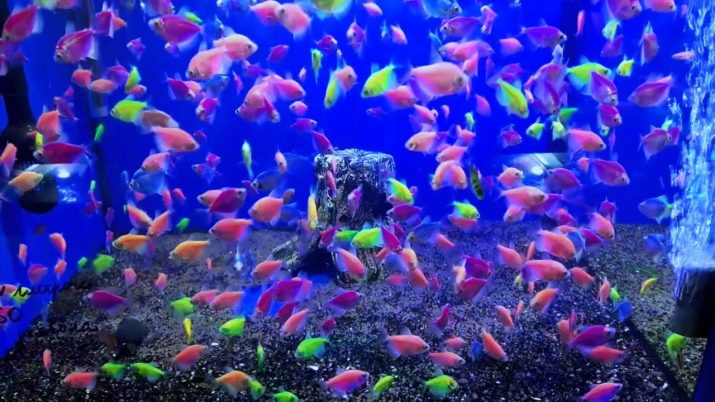
For information on the characteristics of glofish aquarium fish, see the next video.








